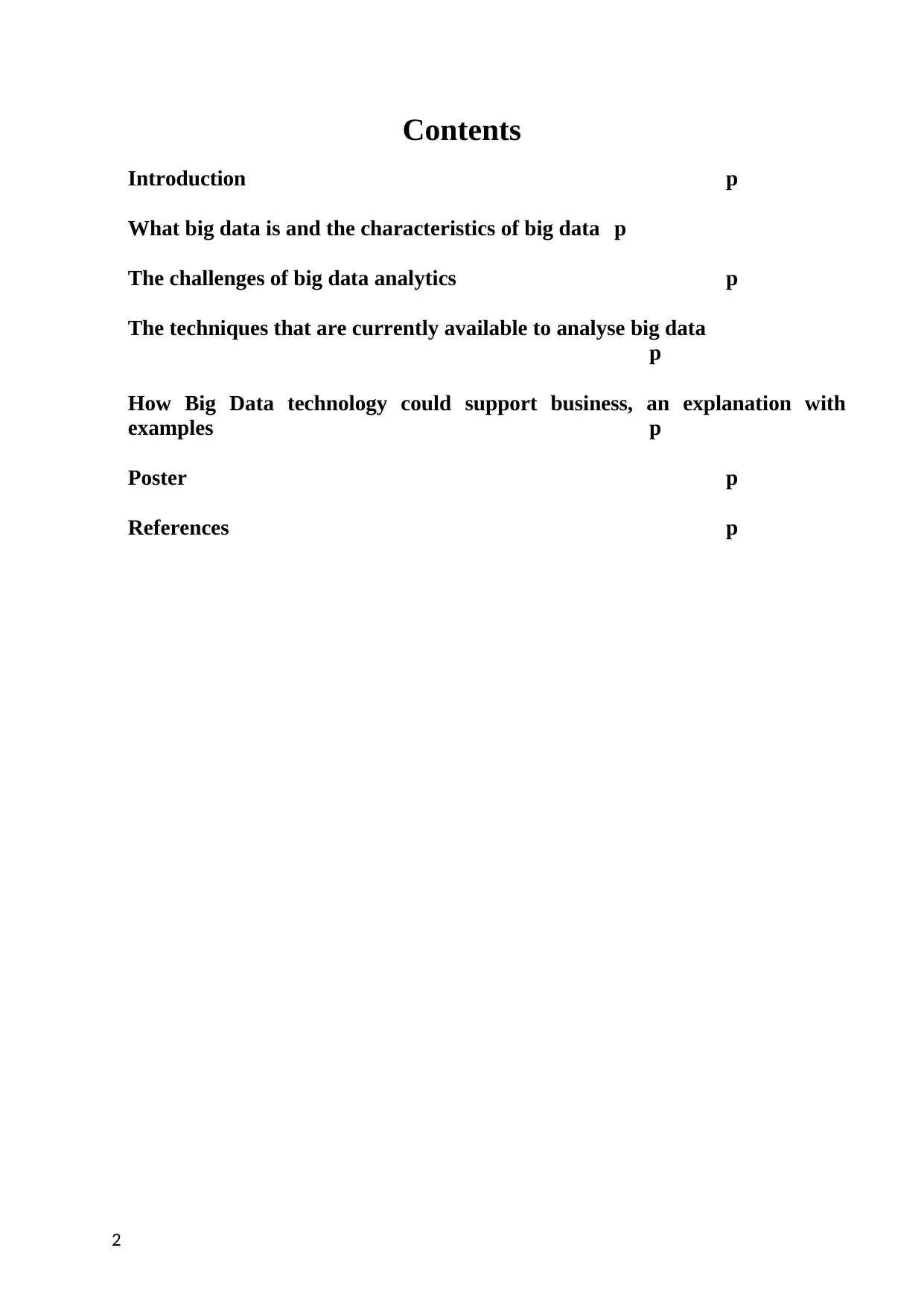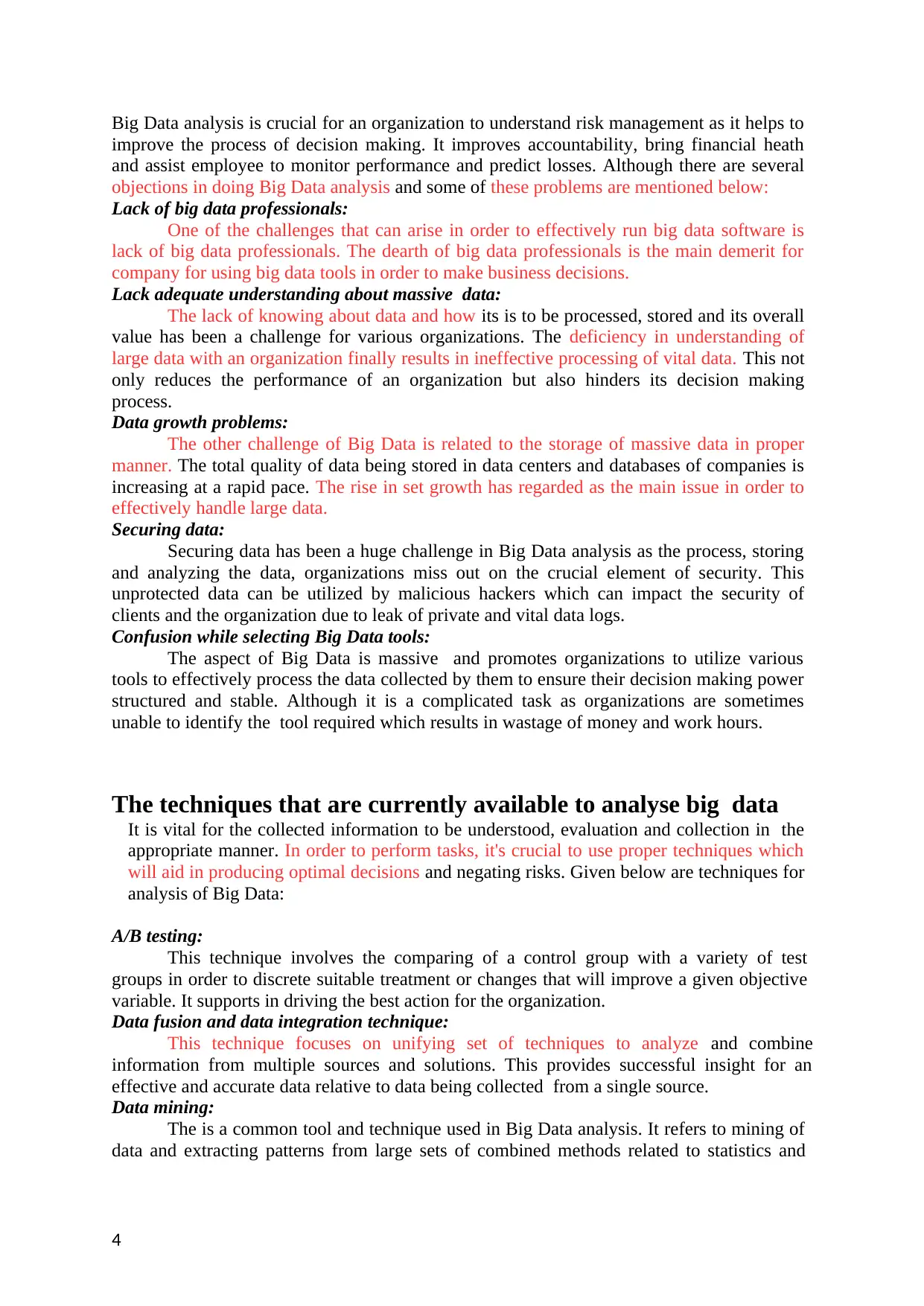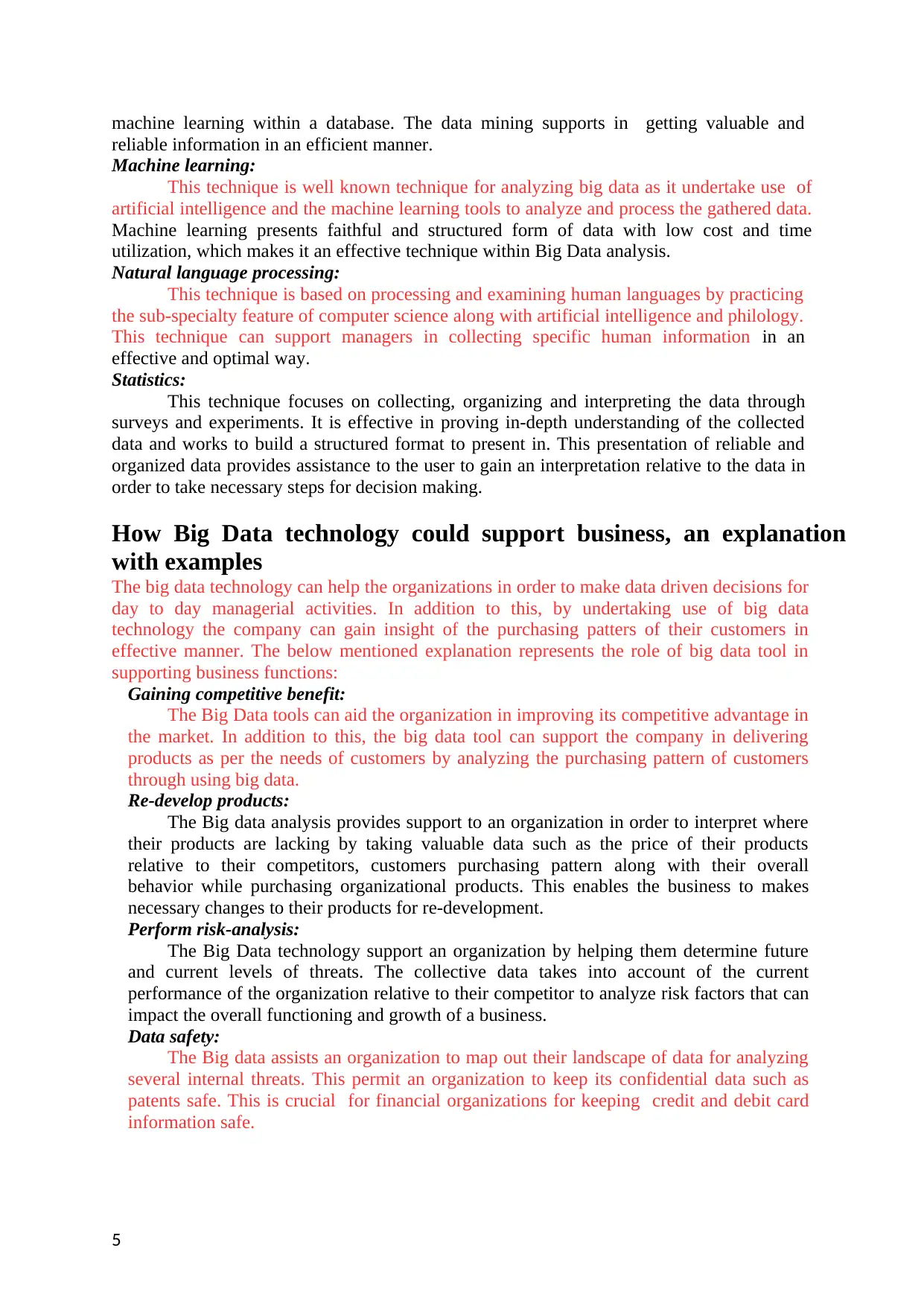Business Management: Information Systems & Big Data Analysis Report
VerifiedAdded on 2023/06/17
|8
|1896
|70
Report
AI Summary
This report provides an overview of Big Data analytics in business management, discussing the characteristics of Big Data (volume, variety, velocity, value, and veracity) and the challenges associated with its analysis, such as the lack of professionals, inadequate understanding of data, data growth problems, security concerns, and confusion in selecting appropriate tools. It explores various techniques for analyzing Big Data, including A/B testing, data fusion and integration, data mining, machine learning, natural language processing, and statistics. The report also highlights how Big Data technology can support businesses by gaining competitive advantages, re-developing products, performing risk analysis, and ensuring data safety, using TESCO as an example. This document is available on Desklib, where students can find a wealth of study resources.

Business Management
BMP4005
Information Systems and Big Data Analysis
Poster and Accompanying Paper
Submitted by:
Name:
ID:
1
BMP4005
Information Systems and Big Data Analysis
Poster and Accompanying Paper
Submitted by:
Name:
ID:
1
Paraphrase This Document
Need a fresh take? Get an instant paraphrase of this document with our AI Paraphraser

Contents
Introduction p
What big data is and the characteristics of big data p
The challenges of big data analytics p
The techniques that are currently available to analyse big data
p
How Big Data technology could support business, an explanation with
examples p
Poster p
References p
2
Introduction p
What big data is and the characteristics of big data p
The challenges of big data analytics p
The techniques that are currently available to analyse big data
p
How Big Data technology could support business, an explanation with
examples p
Poster p
References p
2

Introduction
Big Data analytic provide an endless sources and insight to businesses which are essential in
order to bring improvement in performance and attain the ability to identify new unrealized
opportunists across almost every industry along with providing assistance in customer
personalize. Reducing risks. Early detection of fraud and internal operation. It assists an
organization to identify its hidden value through the collective data. The following poster will
includes understanding of Big Data analytic and its characteristics along with its challenges.
Moreover, it will include the techniques that are currently available to analyses big data and
how it can support businesses.
What big data is and the characteristics of big data?
Big Data is regarded as the massive collection of data in the form of structured and
unstructured piece of data. The information is basically collected from the customer profiles,
information servers, from financial statements as well as from the records of employees. The
big data supports the manager in making data driven decisions for achieving goals in
effective manner. The following are the characteristics of big data:
Volume:
The volume represents large amount of information which is gathered and rendered
by large organization in each second. The data is collected from different sources such as
social media platforms, videos as well as from financial statements. The volume of the data is
crucial in order to understand its value as it determines if the collected data is relevant.
Variety:
This characteristic of big data is considered as one of the critical element as it deals
with collection of information from different sources of different nature. The sources include
the information from audio files, text files as well as PDF.
Velocity:
This element of Big Data refers to the overall velocity at which the information is
being processed. The speed of data production is linked with how efficiently the data is
being processed which is essential for effective investigation and helps in meeting demands
of the users.
Value:
This is a vital feature of Big Data as the collected data is needed to be analyzed by
managers in order to make business decisions. It is crucial for the raw data to be collected
effectively and is cleared of irrelevant data in order to identify patterns for the process to be
successful.
Veracity:
This element of Big Data deals with checking the accuracy of data collected as most
of the data is collected in the form of unstructured form. This makes it crucial for filtering
necessary and required information in order to process effectively. This ensure that all the
data is collected in the relevant as well as effective manner.
The challenges of big data analytics
3
Big Data analytic provide an endless sources and insight to businesses which are essential in
order to bring improvement in performance and attain the ability to identify new unrealized
opportunists across almost every industry along with providing assistance in customer
personalize. Reducing risks. Early detection of fraud and internal operation. It assists an
organization to identify its hidden value through the collective data. The following poster will
includes understanding of Big Data analytic and its characteristics along with its challenges.
Moreover, it will include the techniques that are currently available to analyses big data and
how it can support businesses.
What big data is and the characteristics of big data?
Big Data is regarded as the massive collection of data in the form of structured and
unstructured piece of data. The information is basically collected from the customer profiles,
information servers, from financial statements as well as from the records of employees. The
big data supports the manager in making data driven decisions for achieving goals in
effective manner. The following are the characteristics of big data:
Volume:
The volume represents large amount of information which is gathered and rendered
by large organization in each second. The data is collected from different sources such as
social media platforms, videos as well as from financial statements. The volume of the data is
crucial in order to understand its value as it determines if the collected data is relevant.
Variety:
This characteristic of big data is considered as one of the critical element as it deals
with collection of information from different sources of different nature. The sources include
the information from audio files, text files as well as PDF.
Velocity:
This element of Big Data refers to the overall velocity at which the information is
being processed. The speed of data production is linked with how efficiently the data is
being processed which is essential for effective investigation and helps in meeting demands
of the users.
Value:
This is a vital feature of Big Data as the collected data is needed to be analyzed by
managers in order to make business decisions. It is crucial for the raw data to be collected
effectively and is cleared of irrelevant data in order to identify patterns for the process to be
successful.
Veracity:
This element of Big Data deals with checking the accuracy of data collected as most
of the data is collected in the form of unstructured form. This makes it crucial for filtering
necessary and required information in order to process effectively. This ensure that all the
data is collected in the relevant as well as effective manner.
The challenges of big data analytics
3
⊘ This is a preview!⊘
Do you want full access?
Subscribe today to unlock all pages.

Trusted by 1+ million students worldwide

Big Data analysis is crucial for an organization to understand risk management as it helps to
improve the process of decision making. It improves accountability, bring financial heath
and assist employee to monitor performance and predict losses. Although there are several
objections in doing Big Data analysis and some of these problems are mentioned below:
Lack of big data professionals:
One of the challenges that can arise in order to effectively run big data software is
lack of big data professionals. The dearth of big data professionals is the main demerit for
company for using big data tools in order to make business decisions.
Lack adequate understanding about massive data:
The lack of knowing about data and how its is to be processed, stored and its overall
value has been a challenge for various organizations. The deficiency in understanding of
large data with an organization finally results in ineffective processing of vital data. This not
only reduces the performance of an organization but also hinders its decision making
process.
Data growth problems:
The other challenge of Big Data is related to the storage of massive data in proper
manner. The total quality of data being stored in data centers and databases of companies is
increasing at a rapid pace. The rise in set growth has regarded as the main issue in order to
effectively handle large data.
Securing data:
Securing data has been a huge challenge in Big Data analysis as the process, storing
and analyzing the data, organizations miss out on the crucial element of security. This
unprotected data can be utilized by malicious hackers which can impact the security of
clients and the organization due to leak of private and vital data logs.
Confusion while selecting Big Data tools:
The aspect of Big Data is massive and promotes organizations to utilize various
tools to effectively process the data collected by them to ensure their decision making power
structured and stable. Although it is a complicated task as organizations are sometimes
unable to identify the tool required which results in wastage of money and work hours.
The techniques that are currently available to analyse big data
It is vital for the collected information to be understood, evaluation and collection in the
appropriate manner. In order to perform tasks, it's crucial to use proper techniques which
will aid in producing optimal decisions and negating risks. Given below are techniques for
analysis of Big Data:
A/B testing:
This technique involves the comparing of a control group with a variety of test
groups in order to discrete suitable treatment or changes that will improve a given objective
variable. It supports in driving the best action for the organization.
Data fusion and data integration technique:
This technique focuses on unifying set of techniques to analyze and combine
information from multiple sources and solutions. This provides successful insight for an
effective and accurate data relative to data being collected from a single source.
Data mining:
The is a common tool and technique used in Big Data analysis. It refers to mining of
data and extracting patterns from large sets of combined methods related to statistics and
4
improve the process of decision making. It improves accountability, bring financial heath
and assist employee to monitor performance and predict losses. Although there are several
objections in doing Big Data analysis and some of these problems are mentioned below:
Lack of big data professionals:
One of the challenges that can arise in order to effectively run big data software is
lack of big data professionals. The dearth of big data professionals is the main demerit for
company for using big data tools in order to make business decisions.
Lack adequate understanding about massive data:
The lack of knowing about data and how its is to be processed, stored and its overall
value has been a challenge for various organizations. The deficiency in understanding of
large data with an organization finally results in ineffective processing of vital data. This not
only reduces the performance of an organization but also hinders its decision making
process.
Data growth problems:
The other challenge of Big Data is related to the storage of massive data in proper
manner. The total quality of data being stored in data centers and databases of companies is
increasing at a rapid pace. The rise in set growth has regarded as the main issue in order to
effectively handle large data.
Securing data:
Securing data has been a huge challenge in Big Data analysis as the process, storing
and analyzing the data, organizations miss out on the crucial element of security. This
unprotected data can be utilized by malicious hackers which can impact the security of
clients and the organization due to leak of private and vital data logs.
Confusion while selecting Big Data tools:
The aspect of Big Data is massive and promotes organizations to utilize various
tools to effectively process the data collected by them to ensure their decision making power
structured and stable. Although it is a complicated task as organizations are sometimes
unable to identify the tool required which results in wastage of money and work hours.
The techniques that are currently available to analyse big data
It is vital for the collected information to be understood, evaluation and collection in the
appropriate manner. In order to perform tasks, it's crucial to use proper techniques which
will aid in producing optimal decisions and negating risks. Given below are techniques for
analysis of Big Data:
A/B testing:
This technique involves the comparing of a control group with a variety of test
groups in order to discrete suitable treatment or changes that will improve a given objective
variable. It supports in driving the best action for the organization.
Data fusion and data integration technique:
This technique focuses on unifying set of techniques to analyze and combine
information from multiple sources and solutions. This provides successful insight for an
effective and accurate data relative to data being collected from a single source.
Data mining:
The is a common tool and technique used in Big Data analysis. It refers to mining of
data and extracting patterns from large sets of combined methods related to statistics and
4
Paraphrase This Document
Need a fresh take? Get an instant paraphrase of this document with our AI Paraphraser

machine learning within a database. The data mining supports in getting valuable and
reliable information in an efficient manner.
Machine learning:
This technique is well known technique for analyzing big data as it undertake use of
artificial intelligence and the machine learning tools to analyze and process the gathered data.
Machine learning presents faithful and structured form of data with low cost and time
utilization, which makes it an effective technique within Big Data analysis.
Natural language processing:
This technique is based on processing and examining human languages by practicing
the sub-specialty feature of computer science along with artificial intelligence and philology.
This technique can support managers in collecting specific human information in an
effective and optimal way.
Statistics:
This technique focuses on collecting, organizing and interpreting the data through
surveys and experiments. It is effective in proving in-depth understanding of the collected
data and works to build a structured format to present in. This presentation of reliable and
organized data provides assistance to the user to gain an interpretation relative to the data in
order to take necessary steps for decision making.
How Big Data technology could support business, an explanation
with examples
The big data technology can help the organizations in order to make data driven decisions for
day to day managerial activities. In addition to this, by undertaking use of big data
technology the company can gain insight of the purchasing patters of their customers in
effective manner. The below mentioned explanation represents the role of big data tool in
supporting business functions:
Gaining competitive benefit:
The Big Data tools can aid the organization in improving its competitive advantage in
the market. In addition to this, the big data tool can support the company in delivering
products as per the needs of customers by analyzing the purchasing pattern of customers
through using big data.
Re-develop products:
The Big data analysis provides support to an organization in order to interpret where
their products are lacking by taking valuable data such as the price of their products
relative to their competitors, customers purchasing pattern along with their overall
behavior while purchasing organizational products. This enables the business to makes
necessary changes to their products for re-development.
Perform risk-analysis:
The Big Data technology support an organization by helping them determine future
and current levels of threats. The collective data takes into account of the current
performance of the organization relative to their competitor to analyze risk factors that can
impact the overall functioning and growth of a business.
Data safety:
The Big data assists an organization to map out their landscape of data for analyzing
several internal threats. This permit an organization to keep its confidential data such as
patents safe. This is crucial for financial organizations for keeping credit and debit card
information safe.
5
reliable information in an efficient manner.
Machine learning:
This technique is well known technique for analyzing big data as it undertake use of
artificial intelligence and the machine learning tools to analyze and process the gathered data.
Machine learning presents faithful and structured form of data with low cost and time
utilization, which makes it an effective technique within Big Data analysis.
Natural language processing:
This technique is based on processing and examining human languages by practicing
the sub-specialty feature of computer science along with artificial intelligence and philology.
This technique can support managers in collecting specific human information in an
effective and optimal way.
Statistics:
This technique focuses on collecting, organizing and interpreting the data through
surveys and experiments. It is effective in proving in-depth understanding of the collected
data and works to build a structured format to present in. This presentation of reliable and
organized data provides assistance to the user to gain an interpretation relative to the data in
order to take necessary steps for decision making.
How Big Data technology could support business, an explanation
with examples
The big data technology can help the organizations in order to make data driven decisions for
day to day managerial activities. In addition to this, by undertaking use of big data
technology the company can gain insight of the purchasing patters of their customers in
effective manner. The below mentioned explanation represents the role of big data tool in
supporting business functions:
Gaining competitive benefit:
The Big Data tools can aid the organization in improving its competitive advantage in
the market. In addition to this, the big data tool can support the company in delivering
products as per the needs of customers by analyzing the purchasing pattern of customers
through using big data.
Re-develop products:
The Big data analysis provides support to an organization in order to interpret where
their products are lacking by taking valuable data such as the price of their products
relative to their competitors, customers purchasing pattern along with their overall
behavior while purchasing organizational products. This enables the business to makes
necessary changes to their products for re-development.
Perform risk-analysis:
The Big Data technology support an organization by helping them determine future
and current levels of threats. The collective data takes into account of the current
performance of the organization relative to their competitor to analyze risk factors that can
impact the overall functioning and growth of a business.
Data safety:
The Big data assists an organization to map out their landscape of data for analyzing
several internal threats. This permit an organization to keep its confidential data such as
patents safe. This is crucial for financial organizations for keeping credit and debit card
information safe.
5

The TESCO company can be taken as an example as Big data technology can support the
company in determining competition level as well as can improve its services in effective
manner. In addition to this, it enables the company to make corrective decision and take
suitable action for growth and success in the market.
Poster
6
company in determining competition level as well as can improve its services in effective
manner. In addition to this, it enables the company to make corrective decision and take
suitable action for growth and success in the market.
Poster
6
⊘ This is a preview!⊘
Do you want full access?
Subscribe today to unlock all pages.

Trusted by 1+ million students worldwide

7
Paraphrase This Document
Need a fresh take? Get an instant paraphrase of this document with our AI Paraphraser

References
Books & Journals:
Chauhan, R., Kaur, H. and Chang, V., 2021. An Optimized Integrated Framework of Big
Data Analytics Managing Security and Privacy in Healthcare Data. Wireless
Personal Communications, 117(1).
De Santis, F. and D’Onza, G., 2021. Big data and data analytics in auditing: in search of
legitimacy. Meditari Accountancy Research.
Deshpande, P. S., Sharma, S. C. and Peddoju, S. K., 2019. Predictive and prescriptive
analytics in Big-data Era. In Security and data storage aspect in cloud
computing (pp. 71-81). Springer, Singapore.
Pathak, A. R., Pandey, M. and Rautaray, S. S., 2020. Approaches of enhancing
interoperations among high performance computing and big data analytics via
augmentation. Cluster Computing, 23(2). pp.953-988.
Verma, N., Malhotra, D. and Singh, J., 2020. Big data analytics for retail industry using
MapReduce-Apriori framework. Journal of Management Analytics, 7(3). pp.424-
442.
Yang and et. al., 2020. A big data analytics framework for detecting user-level depression
from social networks. International Journal of Information Management, 54.
p.102141.
8
Books & Journals:
Chauhan, R., Kaur, H. and Chang, V., 2021. An Optimized Integrated Framework of Big
Data Analytics Managing Security and Privacy in Healthcare Data. Wireless
Personal Communications, 117(1).
De Santis, F. and D’Onza, G., 2021. Big data and data analytics in auditing: in search of
legitimacy. Meditari Accountancy Research.
Deshpande, P. S., Sharma, S. C. and Peddoju, S. K., 2019. Predictive and prescriptive
analytics in Big-data Era. In Security and data storage aspect in cloud
computing (pp. 71-81). Springer, Singapore.
Pathak, A. R., Pandey, M. and Rautaray, S. S., 2020. Approaches of enhancing
interoperations among high performance computing and big data analytics via
augmentation. Cluster Computing, 23(2). pp.953-988.
Verma, N., Malhotra, D. and Singh, J., 2020. Big data analytics for retail industry using
MapReduce-Apriori framework. Journal of Management Analytics, 7(3). pp.424-
442.
Yang and et. al., 2020. A big data analytics framework for detecting user-level depression
from social networks. International Journal of Information Management, 54.
p.102141.
8
1 out of 8
Related Documents
Your All-in-One AI-Powered Toolkit for Academic Success.
+13062052269
info@desklib.com
Available 24*7 on WhatsApp / Email
![[object Object]](/_next/static/media/star-bottom.7253800d.svg)
Unlock your academic potential
Copyright © 2020–2025 A2Z Services. All Rights Reserved. Developed and managed by ZUCOL.


